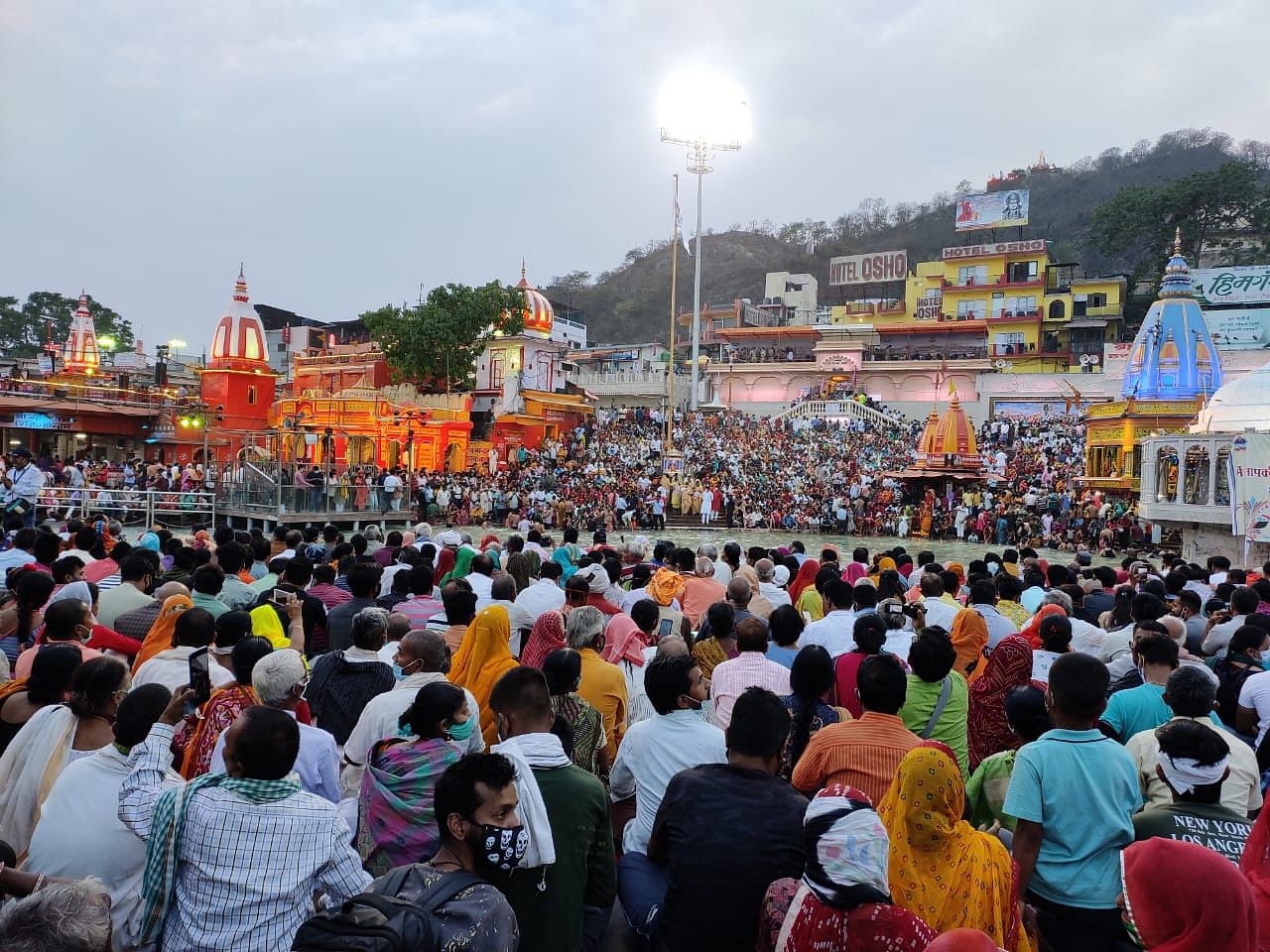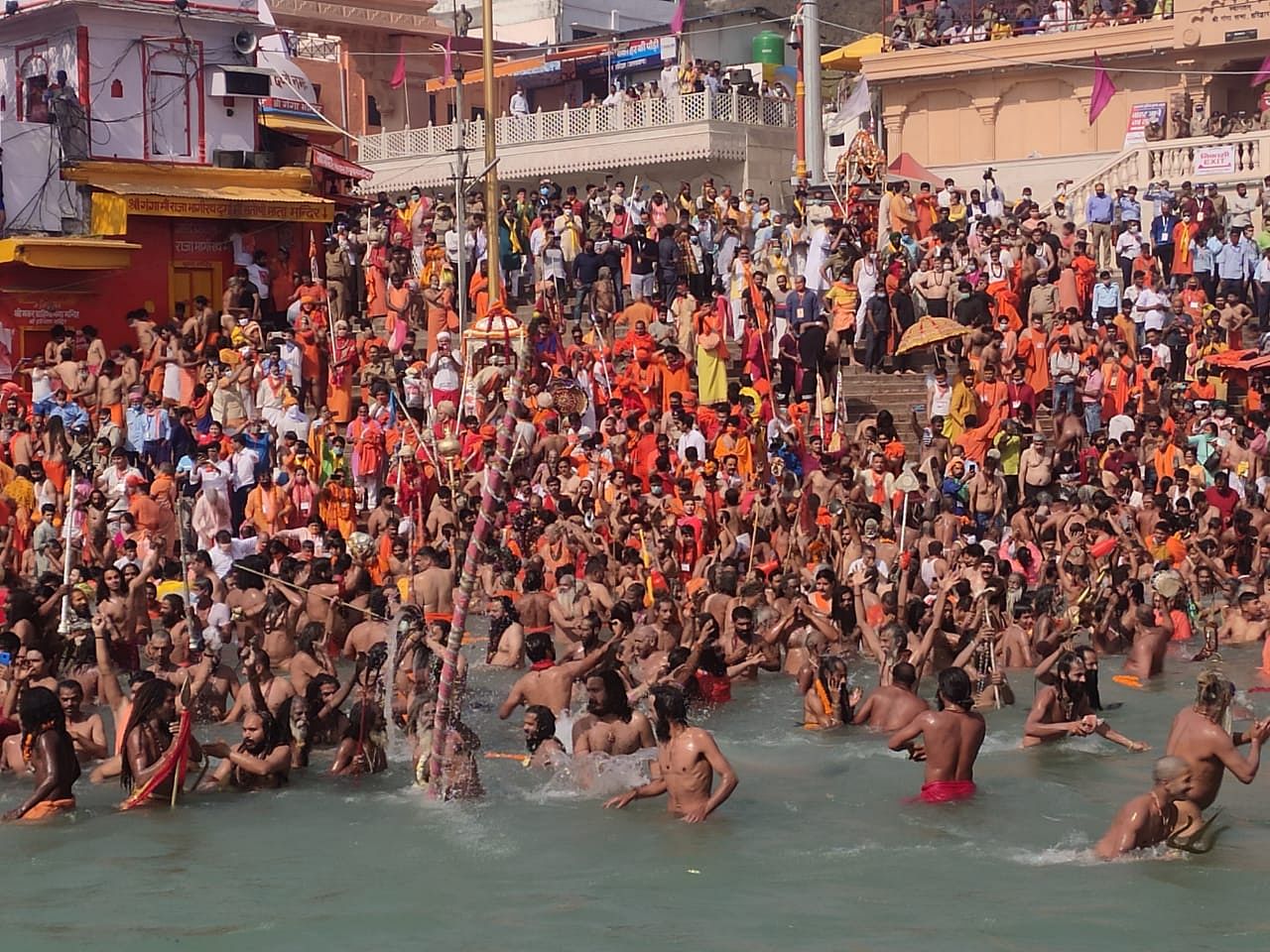Haridwar: At the Kumbh Mela in Haridwar, a voice drones on from a large loudspeaker. “Maintain distance and stay safe from coronavirus. Wear a mask at all times,” it says on a loop. But the devotees and seers gathered at the mela seem to hear something else altogether.
“It’s the voice of god, who says nothing will happen. God won’t let anything happen to us. I have full faith,” said Baba Prakash Puri Maharaj, a 48-year-old seer from West Bengal, dripping wet from the dip he had just taken in the Ganga. Moments before, thousands like him were packed together on the banks of the river, barely inches apart, jostling to get into the water.
The Har ki Pauri — the point where the devotees had congregated — is where the Ganga meets the plains for the first time on its way down from the mountains. It’s considered the holiest ghat because Lord Vishnu is believed to have stepped in the area on his way to Bhavnagar in Gujarat, leaving behind a large footprint.
For years, devotees have come to the area in lakhs, to take a dip in the holy waters and pray at its banks.
The 2021 Kumbh Mela in Haridwar, which started 1 April and ends 30 April, is no different, with a staggering 13,51,631 people participating in the third “shahi snaan (royal bath)” Wednesday alone. At sunset, tens of thousands of people — from Haridwar and outside the state — gathered for the daily Ganga aarti ritual.

That a second wave of Covid infections is sweeping through the nation appears to bother few. Nor do the cases being diagnosed at the Kumbh mela, where 50 testing booths have been set up.
Haridwar recorded 525 fresh cases of Covid-19 by the end of day Wednesday, 119 of which came from the mela. Between 10 and 14 April, 1,701 attendees tested positive for the virus. India, meanwhile, crossed a new high Thursday, recording a daily tally of over 2 lakh cases.
The organisation of the Kumbh Mela amid the pandemic has been controversial from the get-go. However, authorities in Uttarakhand have justified their decision, and promised precautions, like drones to monitor the violations of Covid regulations and restricting entry to those with a valid Covid-negative certificate.
On the ground, however, police have struggled to implement restrictions and enforce masking and distancing, and there appears to be no random sampling. For many devotees, the whole Covid affair is nothing but background noise, and they are convinced their faith will protect them.
“You see, Covid affects those who are greedy, who sleep in AC and whose immunity weakens. We sadhus sleep on the ground, our immunity is strong. We don’t run after things,” said another sadhu, who referred to himself only as “Mahatma”. “Covid won’t affect us. It only affects thieves.”
Also read: British govt to Modi govt — How Kumbh Mela has been organised through epidemics
‘Not possible to enforce restrictions’
The Kumbh Mela area is spread over 670 hectares covering parts of Haridwar, Tehri and Dehradun districts, including Rishikesh. The fact that the mela is held outdoors has been among the major grounds cited by the state government to defend their decision.
Uttarakhand Chief Minister Tirath Singh Rawat said earlier this week that the “flow and blessings of Ma Ganga will ensure coronavirus doesn’t spread”.
“The mela normally starts in January but it was pushed to April because of Covid, and is being kept only for one month as opposed to three. We asked the central government for guidance, and they provided us with a detailed standard operating procedure which we have been following. It’s as simple as that,” said mela officer Deepak Rawat, who has been tasked by the state government to handle the mela’s organisation.
However, amid the feeling of devotion that pervades Haridwar, there appears to be a general disregard for Covid-19 guidelines.
A walk around the akhadas (ascetic/seer groups) and the Har ki Pauri area revealed dozens of people streaming through the narrow streets without a mask, with police making no effort to enforce rules.
When the evening aarti began, scores of people sat huddled together, some without masks. Police supervised the crowds, but didn’t urge distancing. Drones flew overhead, but they might as well not have been.
“This is a small area, and darshan and snaan are a must for everyone. It’s not possible to enforce any social distancing,” said a police officer stationed at Har ki Pauri. “Sometimes people are receptive and listen, at other times they are defiant and don’t. But it’s not possible to enforce it.”

The 50 testing booths set up at the mela have a capacity to conduct over 50,000 tests per day, according to Dr Avinash Khanna, the Covid nodal officer for the kumbh.
On 1 April, the Uttarakhand High Court said 50,000 tests have to be conducted per day at the mela to avoid missing infections, but following this order has been a challenge for the administration.
Most people who are tested, it was learnt, come to the booths of their own volition, and random sampling is not actively pursued.
On days of the shahi snaan — of which there were three this year — at least two testing booths (Mahila ghat and Malviya ghat) were unable to conduct tests because the areas were shut off to all but seers.
“It’s very difficult to get people tested. Some of our testing staff has requested police protection because people can become aggressive when asked to get tested,” Dr Khanna said.
When ThePrint visited, testing booths were mostly empty even as crowds thronged around. Doctors and nurses waited for people to approach them at the booths, rather than seeking people out.
Rakesh Arya, a nursing student conducting Covid tests, said, “Where our booth is stationed is an area that is frequented mostly by local residents. When we ask them to wear a mask or come get tested, they tell us that they are locals and that there is no need for it and tell us to leave them alone. People from outside have to bring in a negative certificate, but locals are exempt.”
On Wednesday, 13,415 Rapid Antigen Tests and RT-PCR tests were conducted at the booths, 119 of which were found to be positive.
Speaking to news agency PTI about the 1,701 cases diagnosed since 10 April, Haridwar Chief Medical Officer Shambhu Kumar Jha said the trend shows that the number of infected persons in the Kumbh Mela area is likely to climb to 2,000.
Also read: Poll rallies to Kumbh Mela — Modi-Shah’s conscience must take a look at latest Covid surge
At the mela with expired Covid negative certificate
Despite the huge crowds, mela officer Rawat insisted the risk of Covid-19 infection is “low”.
“Only people with a negative certificate are allowed to enter. So the risk of transmission is low. During the procession, if we start enforcing social distancing, it will be counter-productive,” he added.
“On the days there are no processions, we are imposing challans and penalties.”
While several people who come from outside the state do indeed have negative certificates, they aren’t always checked by the kumbh authorities. A negative certificate is considered “valid” only for three days, following which participants are required to undergo another test, but there appeared to be some lag in enforcing this order too.
For example, a group of 25-year-old men who had just holidayed in nearby Rishikesh had Covid negative certificates that had expired by the time they came to Haridwar.
“Our negative reports would be considered expired, since they are more than three days old. They were checked when we crossed the border a few days ago, but not since we came here to the mela,” said Amit Kumar, one among the five. “We’ll get tested again if they want us to, but we have very little time, so we want to enjoy ourselves as much as we can,” he added.
(Edited by Sunanda Ranjan)
Also read: ‘Corona jihad’ to ‘holy dip’ – India’s TV channels shocked at Kumbh but it’s no ‘human bomb’




Harry: Your latest gomutra beer induced rant:
“.. Sadhus live extremely simple life and travel all over the country, so they have higher immunity compared to average Indian ..”
apparently did not work for Mahamandaleshwar Kapil Dev Das of the Nirwani Akhada of Madhya Pradesh who died of Covid-19.
Additionally, several other seers have started to display COVID 19 symptoms.
And then there are those who display symptoms of chronic Modi bhakthi induced mental degradation and rant and rave in The Print.
Well, since PM Modi has allowed the Kumbh Mela to proceed, he too believes that Covid won’t affect Sadhus.
Any guesses at who is the odd man out in G20 ?
Mind boggling that PM Modi would allow this super-spreader event to go on merely for the sake of electoral politics. Ir-responsible to say the least.
On a lighter note, someone has tweeted that the venerable Sadhus prefer to wear their masks around their loins.
Covid won’t affect sadhus’: At Kumbh, many shun masks & distancing, say faith will save them
IT IS TRUE BUT IT IS BECAUSE OF SCIENTIFICREASON.. Most of these Sadhus live extremely simple life and travel all over the country, so they have higher immunity compared to average Indian. Average South Asian has higher immunity compared to Westerners because they live in such filthy environment. So immune system of Sadhus is best. Therefore few if any of them will die because of covid, in contrast to middle class Indian.
Harry: One of your BJP mentors and fellow gomutra drinker Uttarakhand chief minister Tirath Singh Rawat said,
“Ma Ganga will not allow corona to spread.”
Rawat now has COVID !
Has Ma Ganga changed her mind Harry ?